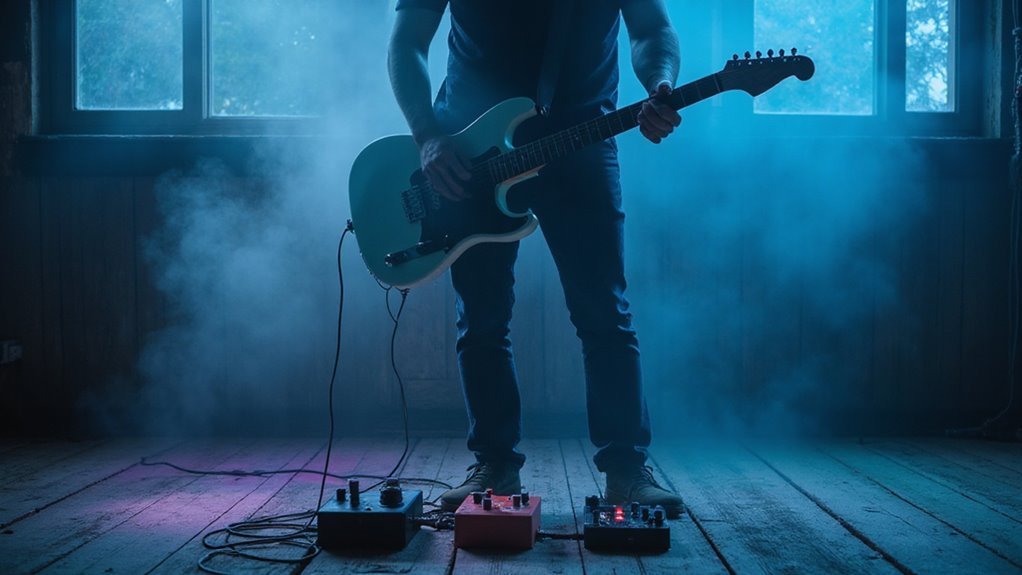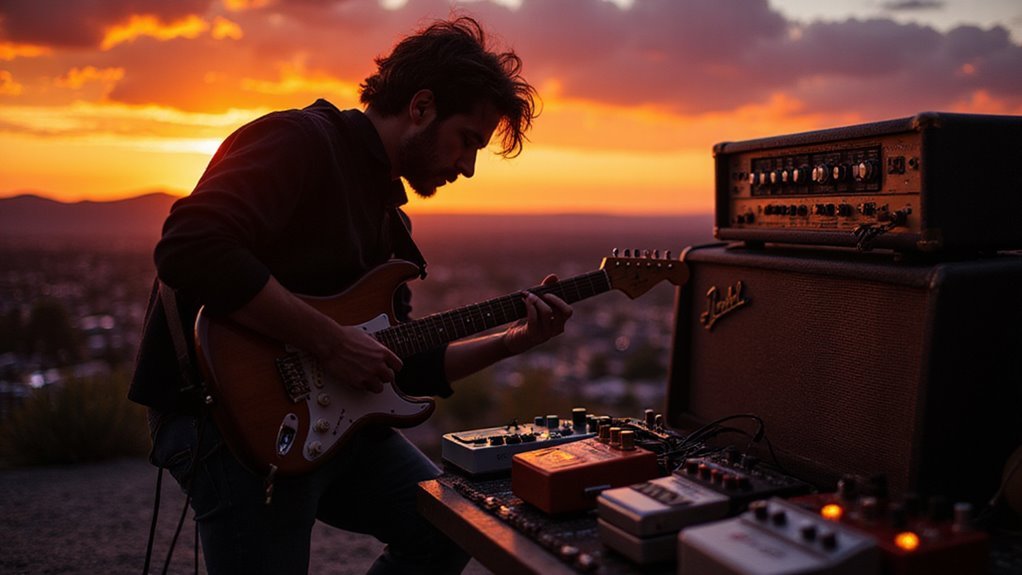Your guitar hides an expansive universe of ambient textures that most players never discover. When you let notes breathe and overlap, they create emotional landscapes far beyond traditional playing approaches. I’ve found that ambient techniques transform even the simplest progressions into immersive experiences that captivate listeners in ways standard playing can’t match. The secret lies not just in what you play, but in the spaces between notes and how you allow sounds to evolve naturally.
The Ethereal Nature of Ambient Guitar

When you first explore the world of ambient guitar, you’re immediately struck by its ethereal quality—a certain weightlessness that seems to defy the traditional boundaries of guitar music.
This isn’t about mastering complex chord progressions or lightning-fast solos. Rather, it’s about creating a space where notes breathe and overlap, where you’re painting with sound instead of playing lines.
I think that’s why so many of us are drawn to it—ambient guitar offers a sense of belonging to something larger than yourself.
Your instrument becomes a portal to emotional landscapes that words can’t quite capture, perhaps connecting you to listeners in ways traditional playing never could.
Fundamental Techniques for Atmospheric Soundscapes

To create truly immersive atmospheric soundscapes with your guitar, you’ll need to master several fundamental techniques that form the backbone of ambient guitar playing.
These approaches transform your instrument from a mere melody maker into a portal for sonic exploration.
- Droning – Sustaining open strings or notes creates that essential ambient foundation.
- Dynamic control – Your touch matters tremendously; subtle volume shifts speak volumes.
- Fingerpicking techniques – Often more effective than picks for nuanced expression.
- Note spacing – Allow your sounds to breathe and overlap naturally.
I think mastering these fundamentals will connect you with the ambient guitar community.
Perhaps start by practicing each technique separately before combining them into your unique atmospheric voice.
Mastering Drones and Layers for Sonic Depth

Most guitarists discover that drones and layers form the essential foundation of compelling ambient music.
When you create a drone by sustaining open strings or harmonics, you’re establishing the tonal center that everything else can build upon. It’s like creating your own musical gravity.
Try starting with a simple drone using your low E string, perhaps with a touch of reverb.
The low E string, when sustained with subtle reverb, creates the perfect foundation for your ambient soundscape.
Then gradually add layers—maybe some delicate harmonics or soft fingerpicked notes in the higher register.
The magic happens when these elements overlap, I think, creating that spacious texture we all crave in ambient music.
Essential Effects Pedals and Signal Chains
Although you can create simple ambient soundscapes with just your guitar, the true sonic magic happens when you introduce effects pedals into your signal chain.
I think the right combination of pedals can transform your playing into lush, atmospheric landscapes that might even surprise you.
The must-have pedals for your ambient journey:
- Reverb – Creates space and dimension (perhaps start with a Hall setting)
- Delay – Adds repeating echoes that build complexity
- Volume pedal – Controls swells and dynamics
- Modulation (chorus/phaser) – Adds movement and texture
Exploring Advanced Techniques: Slides and Higher Registers
Diving beyond the basics reveals a whole new dimension of ambient guitar possibilities. The slide guitar technique, perhaps overlooked by many ambient enthusiasts, offers incredible pitch flexibility that standard fretting can’t match.
You’ll find that even simple melodies transform when played with a slide, creating dreamlike, floating qualities perfect for ambient soundscapes.
Don’t forget about your guitar’s higher registers! These often-neglected upper frets produce delicate, shimmering tones that can add ethereal textures to your compositions.
I think the key is allowing these higher notes to overlap with lower drones, creating that sense of immersion we’re all looking for in ambient music.
Frequently Asked Questions
How Do Weather Conditions Affect Ambient Guitar Performances?
Weather affects your ambient guitar performances through humidity changes that alter tone, cold that detunes strings, and rain that creates unique sonic backdrops you can incorporate into your atmospheric playing.
Can I Create Ambient Sounds Without Purchasing Expensive Equipment?
Yes, you can! With just your guitar, you’ll discover that ambient magic lies in technique—droning, layering, and fingerpicking—not expensive gear. Your creativity matters more than your equipment budget.
How Does Guitar Wood Type Influence Ambient Tone Quality?
Your guitar’s wood greatly shapes ambient tones. Denser woods like maple offer brighter resonance, while mahogany creates warmer, richer textures. You’ll find cedar and spruce perfect for delicate ambient layering.
Are Certain Tunings More Effective for Ambient Compositions?
Yes, alternate tunings like open D, DADGAD, and drop C enhance your ambient compositions by creating richer drones and resonance. You’ll find they’re perfect for layering harmonically related overtones.
How Do You Prevent Feedback When Using Multiple Delays?
You’ll tame the wild feedback monster by lowering your volume, spacing delays strategically in your signal chain, reducing each delay’s feedback knob, and using noise gates between pedals. We’ve all battled this beast!
Conclusion
Like a painter who doesn’t just see colors but feels them, you’re now commencing a similar journey with sound. Your guitar has become more than wood and strings—it’s a vessel for emotions that drift like fog through mountains. As you’ve learned to breathe space into your music, remember: the most powerful landscapes aren’t just seen, but experienced. Your ambient guitar isn’t playing notes; it’s telling stories.